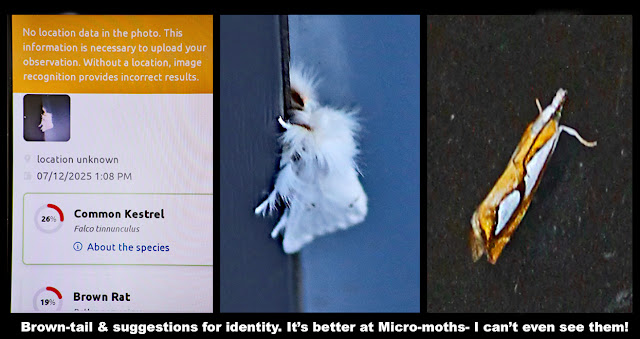Artificial Intelligence vs Human Intelligence
We all have views on AI, usually polarised, and I have to admit when confronted with a chatbot mine becomes very polarised, especially when I have to "ask" three times to contact a human being. Of course the problem here is that the software involved is usually as cheap as possible and the bot only "understands" what is programmed in to it. However, as ever the overall situation is not black and white, and there is some extremely sophisticated and useful AI which we use happily without even thinking about it. From a birder's point of view using photo processing software gives a whole new dimension, not only to what I've just taken, but more importantly, to those poor shots which I took on slide film, such as Slender-billed Curlew, and a completely black (silhouetted) Parrot which I took years ago. In the eyes of a photographer it may be cheating, but I've always been a birder with a camera, so I don't care. I am just thankful I digitised my slides before throwing them away. I can't wait to get some better software which will improve things even more, but I have just upgraded my PC to accept it as it needs more modern hardware.
Of course, there's always a downside to everything. If you are a photographer you aren't producing what you photographed, although cameras themselves use very sophisticated software which makes it easy anyway. I don't understand why people strive for perfection when photographing a bird, but each to their own. Plenty of my photos have been on the web or in books and magazines, and if people don't like them they don't have to look at them (but they will, because they're birders). To me there are two big issues with using AI to process photos. Firstly the nonsensical production of garishly coloured images bearing no relation to reality. At least one Facebook group I've joined bans them, but some people seem to enjoy them. I note increasing use of the term "digital creator". Many people asking to friend me on FB describe themselves as such, but personally I find the term worrying in its implications. I suppose that's my age, but most people I meet are just like me, birders, often with a camera these days. The second issue is that of colour, especially when processing a photo of, say, a Phylloscopus warbler. Apart from the fact that people perceive colours differently anyway, if you haven't really looked at that bird in the wild how do you know the image is correct, and AI can't help with that.
Which brings me to a really big issue with AI, which is identification apps. I am not against them, since in some cases they are invaluable, such as mothing. What used to take hours looking through identification guides now takes minutes, and provided you check the suggested id it is far better than me. I can even identify micro-moths now, because I don't know much about them. But I cannot bring myself to use a bird app, let alone binoculars which tell you what you're looking at. Sound is a different matter, because I've always been poor at remembering calls, plus my hearing isn't good. But being a birder, to me, means learning by experience, and taking pride in being able to identify more difficult species. It is said you never stop learning, and it's true, but if you rely on AI you don't learn, you just tick aother species on your list. Too many people now don't own field guides, I went to Chile not that long ago (1990) when the only guide available was in black and white and Spanish. I translated the bird names and colours in the descriptions, but a friend went as far as trying to colour them in! I sat on the flight home and to pass the time tried to write down the 300 species we had seen from memory. I got to 298, but I still remember what most of them look like.
If you want to use an app to identify your birds then that's fine, but I just wish that people wouldn't send records to e-bird or anywhere else without confirming them for themselves. A friend of mine, leading a tour, recently pointed out a species, and a participant checked it on Merlin! Someone at the Bird Fair who markets apps tried to explain it to me, but it takes little for AI to get it wrong, and it often does. I recently did some "experiments" using Obsidentify. I use it for moths and it's generally very good. But if the probability is less than 95% you cannot rely on it, although it does give some amusement. I often find re-taking a photo, or using a different image, makes a difference, but I photographed a Brown-tail, and put it in for fun. Among the 16 possible identifications were Brown-tail (58%), Long-eared and Western Barn Owls, Beech Marten, Badger, and Striped Snail. The correct ID didn't even appear for the first two shots, only when I changed the angle. Always check if you aren't familiar with the species. If this sounds arrogant, I make mistakes, but will admit to them. AI won't.
I'm sure AI will improve, but in the same way that muscles degenerate if not used, what of our eyes and brains?







Comments
Post a Comment